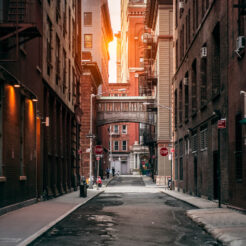Tribeca East Historic District Personal Injury Attorney

Located in Lower Manhattan, the Tribeca East Historic District is part of Tribeca, a larger neighborhood bounded by Canal Street, West Street, Broadway, and either Vesey, Chambers or Murray Streets. The neighborhood takes its name from the reference to “Triangle Below Canal Street,” although Tribeca on a map more resembles a trapezoid than a triangle. Like the rest of Tribeca, Tribeca East includes some of New York City’s most historic buildings, including cast-iron structures and facades combining Italianate, Second Empire and Beaux-Arts styles.
Key Features of the Area
Table of Contents
Originally farmland, Tribeca became a residential and later mercantile area in the 19th century, focusing on textiles, dry goods and produce. One of its nicknames was the “Butter and Eggs District” because of the many wholesale food and dairy markets.
The Tribeca East Historic District contains the original piece of land that earned the entire neighborhood its unique name. Artists and residents moving into the area were inspired by the triangle shape formed by Canal, Church and Lispensard streets.
Today, Tribeca is known as an upscale residential area and one of Manhattan’s most fashionable and expensive neighborhoods, teeming with boutique shops, art galleries, restaurants and bars. Its celebrity residents over the years include playwright Edward Albee, painter Carroll Dunham, actor Robert De Niro, singer/songwriter Mariah Carey and guitarist The Edge from the band U2.
The Importer’s Building, known also as the Textile Building at Leonard and Church streets, is a fine example of this historic district’s architecture. The 12-story neo-Renaissance turn-of-the-century building once contained office space but in 1999 converted to luxury condominiums.+
Brief History of the Tribeca East Historic District
1812: Shipping hubs move from the East River to what’s now known as the Hudson River, leading to the vendor-heavy section of the future Tribeca, then known as Washington Market.
1900 to 1920: With the city’s new subway lines providing better access, Tribeca becomes a bustling commercial center and the center of the cotton and textile trade.
1927: The Holland Tunnel opens, connecting Manhattan to New Jersey and increasing the area’s congestion.
1960s: The produce market moves to Hunts Point in the Bronx, emptying some of Tribeca’s commercial space.
1970s: Former warehouse buildings are converted to residential use, including lofts that attract artists. Legal papers connected with a zoning dispute first formally mention the “TriBeCa Artists’ Co-op,” leading to the name of the larger neighborhood.
1992: The Tribeca East Historic District is formally designated as such.
Location
The Tribeca East Historic District runs south predominantly along the east side of Church Street from Canal Street to Worth Street. It includes areas of Franklin Street stretching east to Cortlandt Alley and west to West Broadway.
Interesting Facts About the Tribeca East Historic District
- The Tribeca East Historic District contains several historical landmarks, including the Ellis Island Immigrant Children Mural at 268 Church St.
- The Pearl River Mart, an eclectic emporium of Asian-inspired fashion, furnishings and gifts, has its flagship store in the Tribeca East Historic District at 395 Broadway.
- New York Law School, founded in 1891 and one of the largest and oldest nonprofit law schools in the country, is located in this historic district at 185 W. Broadway.
Directions to Belluck Law from the Tribeca East Historic District
Belluck Law’s Manhattan asbestos law office is located in Midtown at 546 Fifth Ave., 5th Floor, New York NY 10036. From the Tribeca East Historic District, head north on Church Street to Sixth Avenue. Turn right onto West 46th Street, then right onto Fifth Avenue.
Our law firm also is accessible by taking the 1 subway train from Franklin Street uptown to Times Square/42nd Street and transferring to the 7 train to the Fifth Avenue/Bryant Park station.